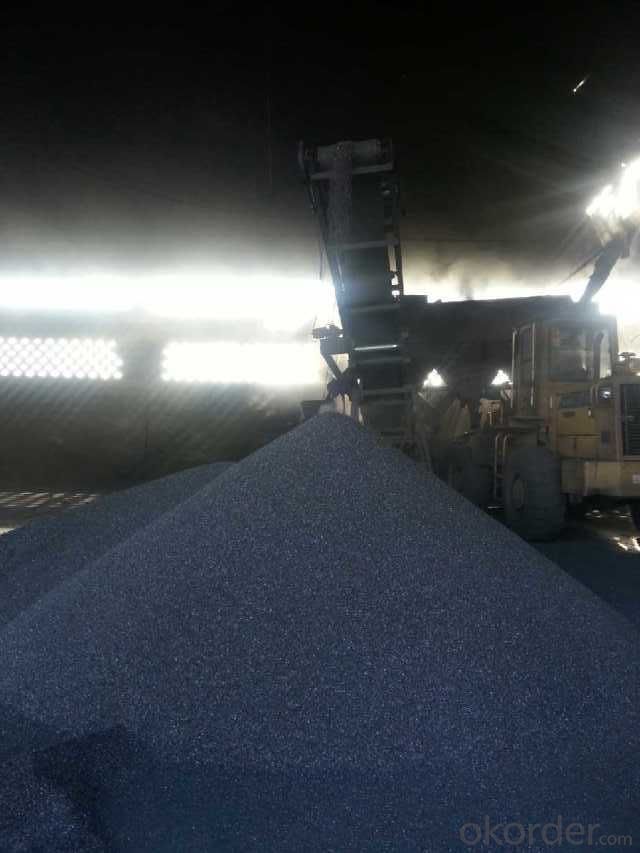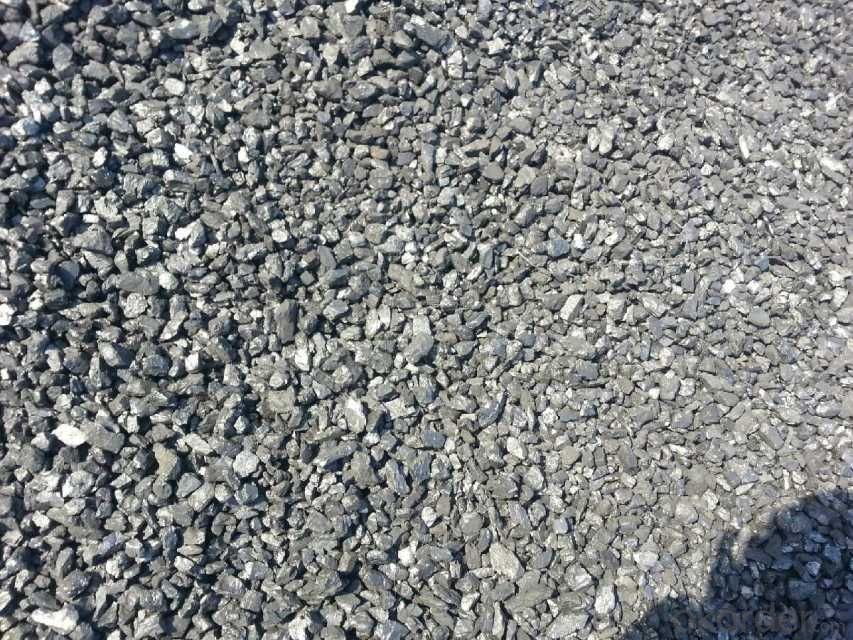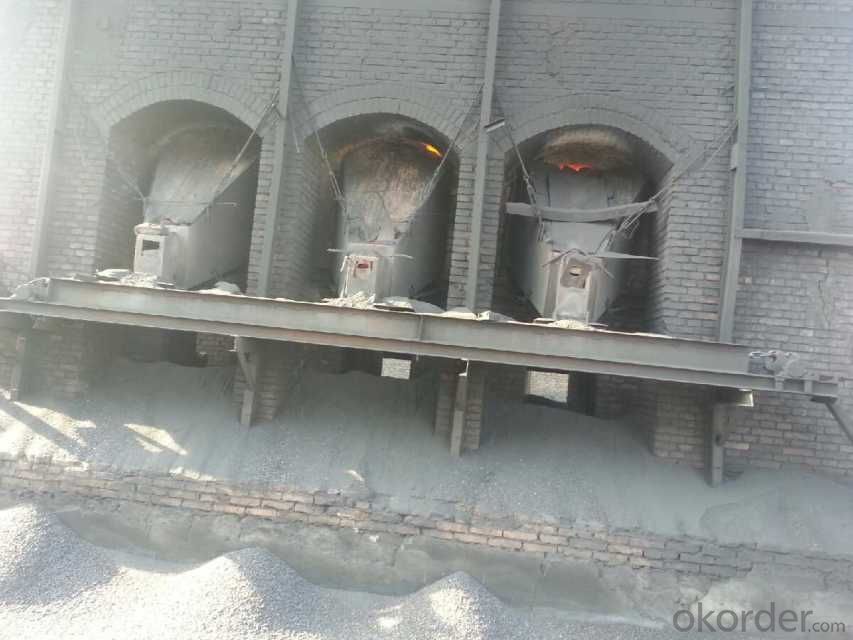FC92 Carbon Additive/CNBM China Carbon Additive
- Loading Port:
- Tianjin
- Payment Terms:
- TT OR LC
- Min Order Qty:
- 0 m.t.
- Supply Capability:
- 100000 m.t./month
OKorder Service Pledge
OKorder Financial Service
You Might Also Like
Product Description
Carbon Additive also called Calcined anthracite Coal, Gas Calcined Anthracite Coal, Carbon Raiser,Recarburizer,etc.
The main raw material of our Carbon Additive is Ningxia unique high quality Taixi anthracite, with characteristic of low ash and low sulfur. Carbon additive has two main usage, fuel and additive. When being used as the carbon additive of steel-smelting, and casting, the fixed carbon may achieve above 95%.
Best quality Taixi anthracite as raw materials through high temperature calcined at 800-1200 ℃ by the DC electric calciner with results in eliminating the moisture and volatile matter from Anthracite efficiently, improving the density and the electric conductivity and strengthening the mechanical strength and anti-oxidation, It has good characteristics with low ash, low resistivity, low carbon and high density. It is the best material for high quality carbon products, it is used as carbon additive in steel industry or fuel.
Packaging & Delivery
| Packaging Detail: | 25kgs/50kgs/1ton per bag or as buyer's request |
| Delivery Detail: | Within 20 days |
Specifications
Calcined Anthracite
Fixed carbon: 90%-95%
S: 0.5% max
Size: 0-3. 3-5.3-15 or as request
Calcined Anthracite is produced using the best Anthracite-Taixi Anthracite with low S and P, It is widely used in steel making and casting.
General Specification of Calcined Anthracite:
PARAMETER UNIT GUARANTEE VALUE | |||||
F.C.% | 95MIN | 94MIN | 93MIN | 92MIN | 90MIN |
ASH % | 4MAX | 5MAX | 6MAX | 7MAX | 8MAX |
V.M.% | 1 MAX | 1MAX | 1.5MAX | 1.5MAX | 1.5MAX |
SULFUR % | 0.5MAX | 0.5MAX | 0.5MAX | 0.5MAX | 0.5MAX |
MOISTURE % | 0.5MAX | 0.5MAX | 0.5MAX | 0.5MAX | 0.5MAX |
Size can be adjusted based on buyer's request.
Pictures of Calcined Anthracite:



- Q:How does carbon affect air quality?
- Air quality can be affected both positively and negatively by carbon. On the one hand, carbon dioxide (CO2) is a natural part of the Earth's atmosphere and vital for plant survival and photosynthesis. Nevertheless, an excess of CO2 can contribute to the greenhouse effect, resulting in global warming and climate change. Furthermore, carbon monoxide (CO), a harmful pollutant produced during incomplete combustion, can have a detrimental impact on air quality. It is primarily released by vehicles, industrial processes, and residential heating systems. Elevated levels of carbon monoxide can impede the body's oxygen delivery, causing various health problems such as headaches, dizziness, and in severe cases, even death. Additionally, compounds containing carbon, like volatile organic compounds (VOCs), can play a role in the creation of ground-level ozone, which is a harmful pollutant. Ground-level ozone can lead to respiratory issues, worsen existing respiratory conditions, and reduce lung function. VOCs are emitted by different sources, including vehicle emissions, industrial processes, and specific household products. In conclusion, while carbon dioxide is crucial for life on Earth, excessive amounts can contribute to climate change. Conversely, carbon monoxide and volatile organic compounds released by human activities can have adverse effects on air quality and human health. Therefore, it is crucial to decrease carbon emissions and adopt cleaner technologies to mitigate the negative impacts of carbon on air quality.
- Q:What are some common compounds of carbon?
- Some common compounds of carbon include carbon dioxide (CO2), methane (CH4), ethane (C2H6), propane (C3H8), butane (C4H10), ethanol (C2H5OH), and acetic acid (CH3COOH).
- Q:How do you stick carbon fabric?
- 6, maintenance(1) after sticking the carbon fiber cloth, it is necessary to conserve 24h naturally to reach initial curing, and ensure that the curing period is free from interference(2) before each process, the resin should be covered with plastic film before it is cured so as to prevent sand or rain from attacking(3) when the temperature of the resin curing is reduced to less than 5 degrees, low temperature curing resin can be adopted, or effective heating measures can be adopted(4) CFRP after natural curing required to meet the design strength of time: the average temperature is 10 DEG C, 2 weeks; the average temperature is 10 degrees centigrade above 20 DEG C, 1 to 2 weeks; the average temperature is higher than 20 degrees in 1 weeks. During this period should be to prevent the patch part by the hard impact.7. PaintingThe coating shall be done after the initial curing of the resin and shall comply with the relevant standards and construction requirements for the coating used
- Q:What's the reason for grading? What about the use of composites? What's the difference?
- 1, carbon fiber has a benzene ring structure, making it difficult to rotate the molecular chain. A polymer molecule cannot fold and stretch to form a rodlike structure, thus giving fibers a high modulus.The linear structure of carbon fiber polymers allows molecules to be arranged so closely that a large number of polymer molecules can be accommodated in a unit volume. This high density makes the fibers stronger.
- Q:How does carbon affect the quality of indoor air?
- Carbon can have a significant impact on the quality of indoor air. One of the main contributors to carbon in indoor air is carbon dioxide (CO2), which is produced through the process of respiration by humans and animals. High levels of CO2 can cause discomfort, as it can lead to feelings of drowsiness, headaches, and difficulty concentrating. In addition to CO2, carbon monoxide (CO) is another carbon compound that can be present in indoor air, mainly due to the incomplete combustion of fossil fuels in stoves, fireplaces, and furnaces. Carbon monoxide is highly toxic and can be life-threatening if present in high concentrations. Apart from these direct sources of carbon, indoor air can also be affected by volatile organic compounds (VOCs), such as formaldehyde, benzene, and toluene. These VOCs are released from various sources like building materials, furniture, cleaning products, and tobacco smoke. They can have adverse health effects, including eye, nose, and throat irritation, headaches, dizziness, and in some cases, even long-term health risks like cancer. To maintain good indoor air quality, it is essential to monitor and control the levels of carbon compounds in the air. Proper ventilation is crucial to ensure fresh air circulation and reduce the concentration of CO2 and other pollutants. Regular maintenance and inspection of fuel-burning appliances can prevent the build-up of carbon monoxide. Using low-VOC or VOC-free materials and products, as well as avoiding smoking indoors, can help minimize the release of harmful carbon compounds.
- Q:What does "carbon neutrality" mean?
- This new term comes from English, "Carbon Neutral"". At present, there is no uniform and fixed name in Chinese, such as carbon neutral, carbon neutral, carbon footprint or carbon balance. Carbon neutrality is one of the modern efforts to slow global warming. The use of this environmentally friendly way, people calculate the CO2 emissions of their daily activities directly or indirectly, and calculate the economic costs to offset the carbon dioxide required, and pay for specialized enterprises or institutions, the amount of carbon dioxide by their corresponding trees or other environmental protection projects to offset the atmosphere.
- Q:What are the consequences of increased carbon emissions on educational systems?
- Increased carbon emissions have profound consequences on educational systems. One of the major consequences is the negative impact on the health and well-being of students and teachers. Carbon emissions contribute to air pollution, which can lead to respiratory problems, allergies, and other health issues. This, in turn, affects attendance rates and overall student performance. Furthermore, the effects of climate change caused by carbon emissions, such as extreme weather events and rising temperatures, can disrupt educational infrastructure. Schools may be closed or damaged due to hurricanes, floods, or heatwaves, leading to a loss of instructional time and disruption to the learning environment. In addition, increased carbon emissions contribute to the depletion of natural resources, such as water and food, which can have severe consequences for educational systems. In regions heavily reliant on agriculture, climate change can disrupt food production and availability, leading to malnutrition and reduced cognitive development in children. Lack of access to clean water can also impact sanitation in schools, increasing the risk of diseases and impacting students' ability to concentrate and learn. Moreover, the consequences of increased carbon emissions extend beyond physical health and infrastructure. Climate change is a complex global issue that requires an understanding of scientific concepts and critical thinking skills to address. However, inadequate education on climate change and its causes can hinder students' ability to comprehend and respond to this pressing issue. Furthermore, the economic impacts of climate change resulting from increased carbon emissions can strain educational systems. Governments may have to divert resources away from education to address climate-related disasters and their aftermath. Limited funding for education can lead to reduced access to quality education, inadequate facilities, and lower teacher salaries, all of which can negatively impact the overall quality of education provided. In conclusion, increased carbon emissions have wide-ranging consequences on educational systems. From the health and well-being of students and teachers to disruptions in infrastructure and access to resources, the effects of carbon emissions can hinder educational outcomes. Addressing climate change and reducing carbon emissions is crucial not just for the environment but also for the future of education.
- Q:What is the concept of carbon equivalent? What is the relationship between carbon equivalent and weldability?
- In order to facilitate the expression of strength properties of these materials and welding performance simply to carbon equivalent to said through the statistics of test data.
- Q:What is fullerene?
- A unique structure resembling a hollow cage or sphere is what constitutes a fullerene, a molecule composed entirely of carbon atoms. Alongside graphite and diamond, it is considered a form of carbon allotrope. The renowned and most commonly known fullerene is referred to as buckminsterfullerene or simply C60, which takes the shape of a soccer ball with 60 carbon atoms. Fullerenes come in a range of sizes, from as little as 20 carbon atoms to several hundred. They can be found naturally in soot or formed through different methods like laser ablation or chemical vapor deposition. With their distinct structure, fullerenes possess exceptional properties, such as high strength, low density, and excellent electrical and thermal conductivity. Therefore, they have found applications in various fields, including nanotechnology, electronics, medicine, and materials science.
- Q:How does carbon affect the formation of haze?
- Carbon plays a significant role in the formation of haze due to its ability to interact with other pollutants and atmospheric conditions. When carbon-containing compounds, such as fossil fuel emissions or organic matter from wildfires, are released into the atmosphere, they undergo chemical reactions with gases like nitrogen oxides and volatile organic compounds. These reactions result in the formation of secondary organic aerosols (SOAs), which are tiny particles suspended in the air. These SOAs can contribute to haze formation by scattering and absorbing sunlight, reducing visibility and creating a hazy appearance. The carbon particles can also serve as condensation nuclei, attracting other pollutants and water vapor, leading to the formation of larger particles and subsequently haze. Additionally, the interaction between carbon and atmospheric moisture can result in the formation of secondary organic aerosol particles that contribute to haze formation. Furthermore, carbon particles can contribute to the formation of photochemical smog, which is a type of haze characterized by high levels of ozone. Carbon-containing pollutants can react with sunlight and other pollutants, leading to the production of ozone. This ozone, along with other pollutants, can contribute to the formation of haze and reduce air quality. In summary, carbon affects the formation of haze by contributing to the formation of secondary organic aerosols, serving as condensation nuclei, and promoting the production of ozone. Understanding the role of carbon in haze formation is crucial for implementing effective air pollution control measures and mitigating the impacts of haze on human health and the environment.
1. Manufacturer Overview |
|
|---|---|
| Location | |
| Year Established | |
| Annual Output Value | |
| Main Markets | |
| Company Certifications | |
2. Manufacturer Certificates |
|
|---|---|
| a) Certification Name | |
| Range | |
| Reference | |
| Validity Period | |
3. Manufacturer Capability |
|
|---|---|
| a)Trade Capacity | |
| Nearest Port | |
| Export Percentage | |
| No.of Employees in Trade Department | |
| Language Spoken: | |
| b)Factory Information | |
| Factory Size: | |
| No. of Production Lines | |
| Contract Manufacturing | |
| Product Price Range | |
Send your message to us
FC92 Carbon Additive/CNBM China Carbon Additive
- Loading Port:
- Tianjin
- Payment Terms:
- TT OR LC
- Min Order Qty:
- 0 m.t.
- Supply Capability:
- 100000 m.t./month
OKorder Service Pledge
OKorder Financial Service
Similar products
New products
Hot products






























